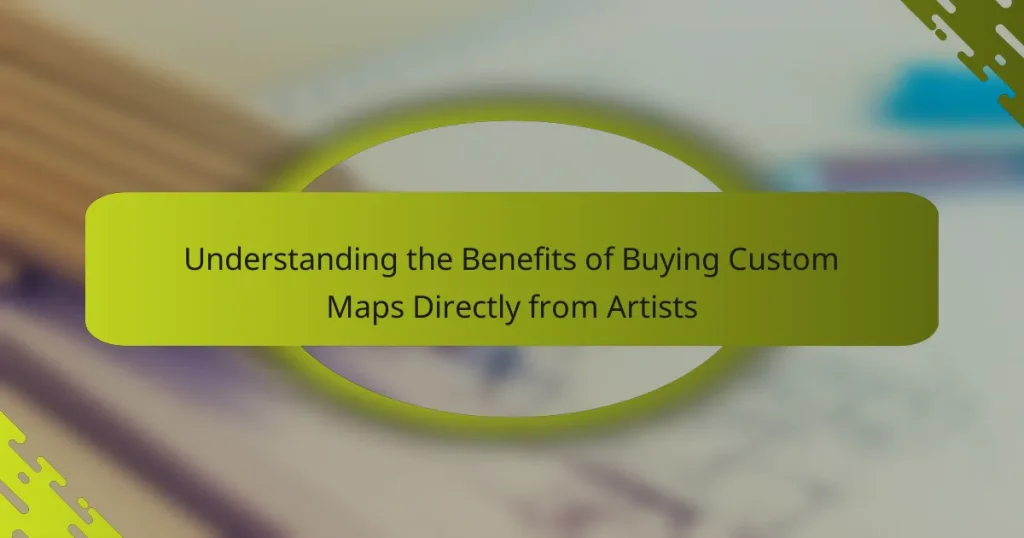
Understanding the Benefits of Buying Custom Maps Directly from Artists
Buying custom maps directly from artists provides a unique opportunity to own personalized designs that…
Custom maps provide innovative solutions that enhance user engagement and deliver tailored geographic insights for businesses. By leveraging tools like Mapbox, Google Maps API, and ArcGIS, organizations can create unique mapping experiences that improve customer interactions and streamline navigation. These tailored maps not only guide users effectively but also enrich their overall experience with relevant location-based information.

Buying custom maps directly from artists provides a unique opportunity to own personalized designs that reflect your individual tastes and experiences. These maps not only serve practical purposes but also act as artistic expressions that can enhance your living space, transforming walls into storytelling canvases. Supporting local creators through your purchase fosters a connection to…
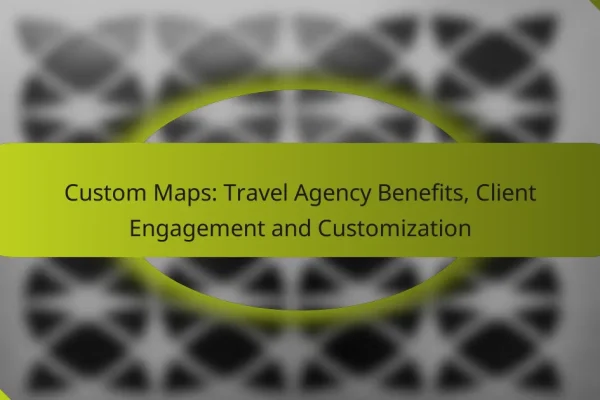
Custom maps offer travel agencies a powerful tool to enhance their services and client engagement. By tailoring visual representations of itineraries and key attractions, these maps not only improve communication but also create personalized experiences that resonate with individual traveler preferences. This innovative approach fosters deeper connections and significantly boosts customer satisfaction. How can custom…
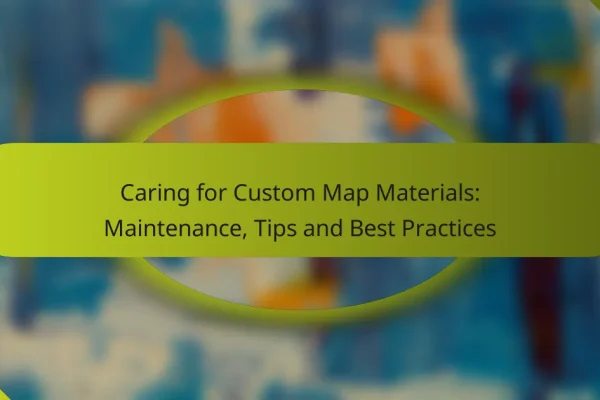
Caring for custom map materials is crucial to ensure their longevity and preserve their aesthetic appeal. By implementing proper maintenance strategies, such as protecting against moisture and UV damage, as well as following specific cleaning practices, you can keep your maps in excellent condition. Regular inspections and appropriate storage solutions further enhance their durability, allowing…

Custom maps are powerful tools that combine aesthetic appeal with functional clarity, making effective color schemes essential for enhancing readability and visual impact. By understanding color interactions and their psychological effects, designers can create maps that are not only visually appealing but also informative and user-friendly. A well-chosen color palette can significantly improve user engagement…

Custom maps have become a popular choice for home offices, blending aesthetic appeal with functionality. By selecting styles that resonate with personal tastes, such as vintage or modern minimalist designs, individuals can create a workspace that inspires productivity while reflecting their unique interests. These maps not only enhance the visual environment but also serve as…
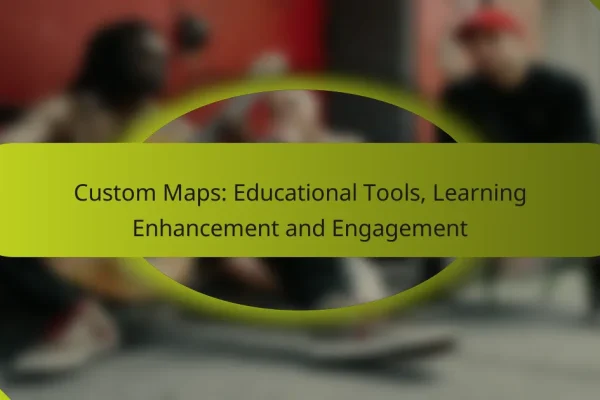
Custom maps serve as powerful educational tools that enhance learning by providing interactive and tailored visual representations of information. By catering to diverse learning styles, these maps make complex subjects more accessible and engaging, ultimately improving comprehension and retention. Various platforms offer user-friendly tools for creating and sharing custom maps, fostering both educational growth and…

Custom maps play a crucial role in historical research by visually representing data that uncovers patterns and trends across time and space. These maps not only enhance the accessibility of complex information but also facilitate a deeper understanding of historical events in their geographical context. By utilizing the right mapping tools, researchers can effectively analyze…

Minimalist design has a profound impact on custom map trends by emphasizing essential features and minimizing visual distractions. This design philosophy not only improves the clarity and usability of maps but also enhances their aesthetic appeal, making them more engaging for users. How does minimalist design influence custom map trends? Minimalist design significantly shapes custom…

Digital technology is revolutionizing custom map design by enhancing interactivity and data visualization while incorporating innovative features like augmented reality. As trends shift towards increased personalization and mobile-first approaches, these advancements create more engaging and accessible maps tailored to user needs. Businesses are leveraging these custom maps to improve navigation and enhance user experiences, ultimately…
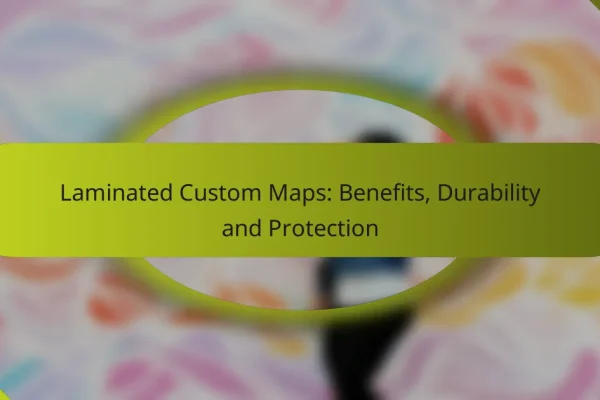
Laminated custom maps provide exceptional durability and protection, making them perfect for outdoor adventures and frequent handling. The lamination process creates a robust barrier against environmental factors, ensuring that the maps remain intact and legible over time. With various high-quality materials available, these maps cater to different needs while promoting longevity and usability. What are…
The best custom map solutions for businesses include tools that enhance user engagement and provide tailored geographic insights. Key options like Mapbox, Google Maps API, and ArcGIS offer unique features suited to different mapping needs.
Mapbox is ideal for creating interactive and visually appealing maps. It allows businesses to customize map styles and integrate real-time data, making it suitable for applications like event planning or location-based services.
Consider using Mapbox if you need high-quality visuals and interactive elements. Its flexibility in design can help brands stand out, but be mindful of potential costs associated with high usage levels.
The Google Maps API is a robust solution for integrating location services into applications. It provides features such as geocoding, directions, and place details, making it a go-to for businesses needing reliable location data.
When using Google Maps API, ensure you understand the pricing structure, which can vary based on usage. It's a great choice for businesses looking to enhance customer experiences through accurate location information.
ArcGIS is a powerful tool for businesses that require in-depth geographic analysis and data visualization. It supports complex spatial analysis, helping organizations make informed decisions based on geographic trends.
Utilize ArcGIS if your business needs to analyze large datasets or create detailed maps for strategic planning. Be prepared for a steeper learning curve and potential licensing fees, but the insights gained can be invaluable.
Custom maps significantly enhance customer experience by providing tailored navigation and relevant location-based information. These maps can guide users through events or direct them to nearby services, making interactions more efficient and enjoyable.
Custom maps for events allow attendees to navigate venues easily, highlighting key areas such as entrances, restrooms, and food stalls. By integrating real-time updates, organizers can inform guests about changes or special activities, enhancing engagement.
For example, a custom map for a festival can include interactive features like a schedule of performances and vendor locations. This not only helps attendees plan their day but also increases foot traffic to specific areas, benefiting vendors and sponsors.
Custom maps can serve as powerful tools for location-based marketing, allowing businesses to target customers based on their geographical location. By integrating maps with promotional offers, companies can attract potential customers who are nearby, increasing conversion rates.
For instance, a restaurant can use a custom map to show its location and highlight special deals for customers within a certain radius. This strategy can lead to increased foot traffic and sales, especially in competitive areas.
Custom mapping software offers tailored solutions that enhance the user experience through unique features. Key aspects include user-friendly interfaces, robust data integration capabilities, and extensive customization options for branding.
A user-friendly interface is crucial for ensuring that all users, regardless of technical expertise, can navigate the mapping software effectively. Intuitive design elements, such as drag-and-drop functionalities and clear menus, simplify the process of creating and modifying maps.
When selecting custom mapping software, look for platforms that prioritize ease of use. Consider trial versions to assess how quickly you can learn the interface and create maps without extensive training.
Data integration capabilities allow custom mapping software to pull in data from various sources, enhancing the map's functionality. This can include real-time data feeds, databases, and APIs, which provide dynamic content for users.
Ensure the software you choose can integrate with the data sources you need, whether they are local databases or cloud-based services. Compatibility with popular formats like CSV or GeoJSON can facilitate smoother data import and export processes.
Customization options for branding enable businesses to tailor the appearance of their maps to align with their corporate identity. This includes modifying colors, logos, and styles to create a cohesive look that resonates with users.
When evaluating custom mapping solutions, check for flexibility in design. The ability to adjust map markers, labels, and overall aesthetics can significantly enhance user engagement and brand recognition.
Custom mapping services typically offer various pricing models to accommodate different needs and budgets. The most common models include subscription-based pricing, one-time purchase options, and freemium models, each with its own advantages and considerations.
Subscription-based pricing allows users to pay a recurring fee, usually monthly or annually, for access to mapping services. This model often includes regular updates, customer support, and additional features as part of the package.
When considering subscription options, evaluate the frequency of updates you need and whether the service offers scalable plans that can grow with your business. For example, a small business might start with a basic plan at around $20 to $50 per month, while larger enterprises may require more comprehensive solutions costing several hundred dollars monthly.
One-time purchase options involve a single upfront payment for a specific mapping solution, which can be appealing for those who prefer not to commit to ongoing fees. This model is often suitable for projects with a defined scope, such as creating a custom map for an event or a specific marketing campaign.
Prices for one-time purchases can vary widely, typically ranging from a few hundred to several thousand dollars, depending on the complexity and customization required. Be sure to clarify what is included in the purchase, such as future updates or support, to avoid unexpected costs later.
Freemium models provide basic mapping services for free, with the option to upgrade to premium features for a fee. This approach is particularly beneficial for startups looking to explore mapping solutions without initial investment.
While freemium services can be a great way to test capabilities, be aware of limitations such as reduced functionality or usage caps. Upgrading to a paid plan may be necessary as your needs grow, often starting at around $10 to $30 per month for enhanced features. Always read the terms to understand what is offered for free and what requires payment.
Choosing the right custom map provider involves evaluating their offerings based on your specific needs, including features, pricing, and user feedback. Prioritize providers that align with your project goals and have a proven track record of quality and reliability.
User reviews and testimonials provide valuable insights into the experiences of others with a custom map provider. Look for feedback on aspects such as customer service, ease of use, and the quality of the maps produced.
Check platforms like Google Reviews, Trustpilot, or industry-specific forums to gather a range of opinions. Pay attention to recurring themes in the reviews, as they can indicate consistent strengths or weaknesses of the provider.
When comparing custom map providers, analyze their pricing structures alongside the features they offer. Some providers may charge a flat fee, while others operate on a subscription basis or per map created.
Identify essential features such as customization options, integration capabilities, and the types of maps available. Create a simple comparison table to visualize differences and make an informed decision based on your budget and requirements.
Custom maps in e-commerce provide tailored visual experiences that enhance user interaction and streamline product navigation. By integrating unique mapping solutions, businesses can significantly improve customer satisfaction and drive sales.
Custom maps can create a more interactive shopping experience, allowing customers to explore products in a visually appealing way. For example, a clothing retailer might use a map to showcase items based on geographical trends, helping customers find styles popular in their region.
Engagement can be further enhanced by incorporating features like location-based promotions or personalized recommendations based on user behavior. This approach not only captivates customers but also encourages them to spend more time on the site.
With custom maps, e-commerce platforms can facilitate easier product discovery by visually organizing items based on categories or locations. This method allows customers to browse products in a more intuitive manner, reducing the time spent searching for specific items.
For instance, a local food market could use a custom map to highlight seasonal produce available in different areas, helping customers quickly find what they need. Implementing filters or clickable areas on the map can further streamline the shopping process, making it efficient and user-friendly.
Creating custom maps involves several challenges, including ensuring data accuracy and effectively integrating with existing systems. Addressing these issues is crucial for producing reliable and functional mapping solutions.
Data accuracy is vital for custom maps, as inaccurate information can lead to misleading representations. Reliable data sources include government databases, satellite imagery, and reputable geographic information systems (GIS). It's essential to verify the credibility of the data before use.
When sourcing data, consider the geographic area and the level of detail required. For instance, urban areas may need more granular data compared to rural regions. Always check for updates to ensure the information remains current.
Integrating custom maps with existing systems can pose significant challenges, particularly regarding compatibility and data flow. Ensure that the mapping solution can work seamlessly with current software and databases to avoid disruptions.
Evaluate the technical requirements of your mapping solution, including APIs and data formats. Using standard formats like GeoJSON or KML can facilitate smoother integration. Additionally, consider conducting a pilot test to identify potential issues before full implementation.